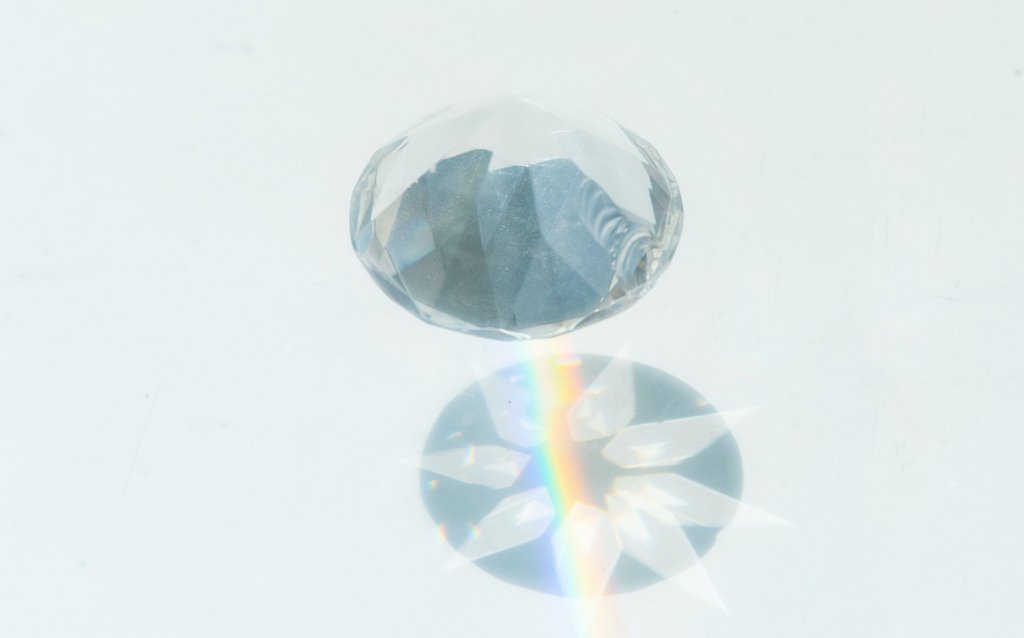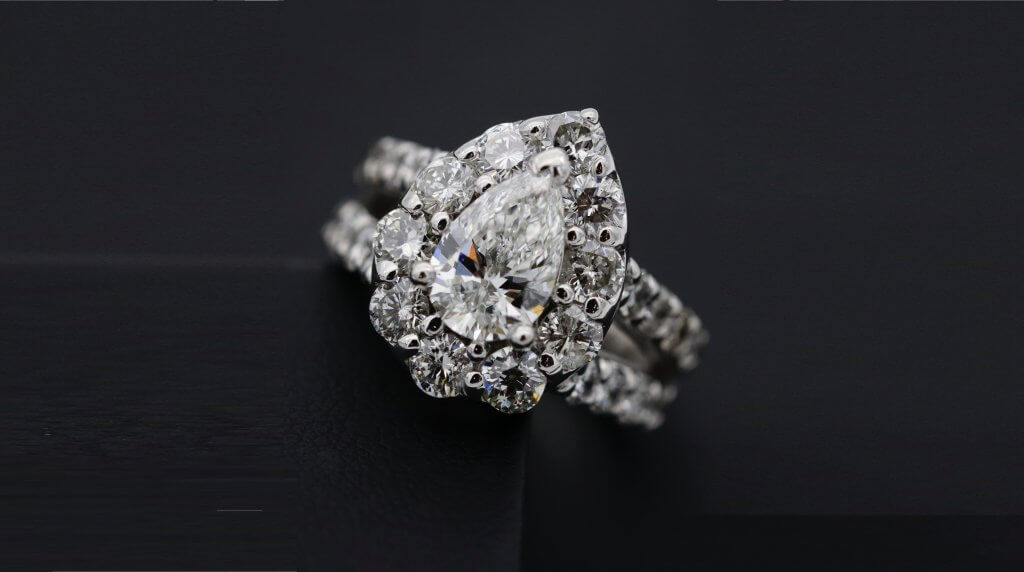The Science Behind Diamonds’ Shine
Key Takeaways
- One of diamond’s most impressive qualities is its high refractive index. This is what causes light to be transformed into a mesmerizing performance and brilliance and fire.
- Brilliance is the term used to refer to the white sparks emitted by a diamond when the light moves across its facets.
- Fire, on the other hand, refers to the colorful flashes of light. Some shapes, like the Cushion, are known for their high level of fire.
- Cloudy or highly fluorescent diamonds will feature much less sparkle than other diamonds not afflicted by these issues, so it’s important to remember that shine and sparkle are not always guaranteed.

Diamonds have a high refractive index and, when cut to a high standard, are able to create mesmerizing light performances unlike any other gemstone. This is why Cut, one of the Four Cs, is so important to get right.
Looking at a rough diamond just mined from the earth or gathered from a murky deposit in a riverbed, you could be forgiven for seeing little to no potential in it. As their name alone suggests, they’re nothing like the symmetrical, glossy, brilliant gemstones we’re used to seeing in jewelry store. Instead, they are a lot like any other rock – irregular, dusty, and coarse – save for one thing: a slight hint of a much greater potential.
In many cases, you only need to take a closer look, and that potential starts jumping out at you. For instance, the octahedron shape, resembles two pyramids placed base-to-base, and it only needs to be split down the middle for the basic shape of the Princess cut, one of the most popular cuts in the diamond world, to begin to appear.
The as-of-yet uncut Sethunya diamond, now housed in the Maison of Louis Vuitton, promises near-impeccable quality and, of course, incredible size and value (the stone currently weighs 549 carats – just under 110 grams. To the uninitiated, however, it could be confused with a lump of sea glass or quartz.
Some of the most prized features of any diamond – color, clarity, and size – are there to see from the very beginning, aside from one: the stones’ characteristic shine and sparkle, which must be brought out by the expert hands they fall into after they are taken from the earth.
What is it called when a diamond shines?
The sparks of light that travel across the surface of any diamond are known as fire and brilliance, and refer to the colored and white sparks respectively.
These are two phrases worth memorizing as you get closer to investing in a diamond of your own.
Some diamonds produce more fire than brilliance, like the Cushion cut, while others create the opposite effect. Some cuts, like the Emerald and Asscher, produce a lot less of either as a result of longer, larger facets – although, as you’ll see for yourself if you’re interested in these shapes, they still produce distinctive patterns of white and colored light.
Do diamonds sparkle or shine?
They do both, since the surface of a diamond is highly polished, but a well-cut diamond’s intense sparkle (that fire and brilliance we mentioned above) means that you’re a lot more likely to notice that, than its shine.
After the diamond has been cut into shape, it is polished on a special wheel until every facet is smooth, and free from any rough texture. This glassy finish means that the diamond will shine under a light source – something you can see most clearly in step cut diamonds, like the Emerald and Asscher – but, in most shapes, will be overwhelmed by the intense sparkle created as the light source roams over their many facets.
But, why does cutting a diamond increase the sparkle? Because creating those facets creates a pathway that light follows through the diamond, and back out. The facets are strategically mapped out before a single cut is made, in order to create the best possible light performance for that particular stone.
What color do real diamonds shine?
Real diamonds reflect both white and colored light – although, as we mentioned above, light performance differs depending on the stone’s shape.
When it comes to light performance, there are clear differences between diamond and any other gemstone. For instance, while common simulants like moissanite and cubic zirconia can do an okay job of resembling diamond in photographs, their different light performances are quick to betray them.
Do diamonds sparkle in low light?
Yes, provided the diamond in question has been cut to a high standard.
As we mentioned above, Cut is the number one factor to consider – and the most important of the Four Cs – when you’re focused, as most people are, on getting a diamond with a beautiful light performance.
Together, diamond’s high refractive index and an impeccable Cut mean that, even in soft candle or lamplight, the stone will still sparkle beautifully.
Why are some diamonds not shiny?
A poor cut is often to blame, but a particularly large cloud inclusion, or strong fluorescence can all cause a diamond to appear dull, lifeless, and lacking in sparkle.
It’s a sad fact that, even with the best cutting techniques, some diamonds simply won’t live up to our expectations. A cloudy appearance is not something that can be fixed, or even improved upon, and that is just one of the many reasons why no one should ever feel comfortable investing in a diamond through the internet.
Our Summary: Why Do Diamonds Shine?
Diamonds shine because of a combination of their innate characteristics, and the work of the diamond cutter. A diamond’s unique refractive index means that generating a high shine is part of its nature, and a cutter’s ability to direct light through the diamond via its facets, are what create that unrivalled display of fire and brilliance.
Keep in mind that some shapes sparkle more than others, and that you should never feel comfortable going to a diamond with a GIA cut grade below Very Good. Diamond proportion is also incredibly important, so understanding how to assess prospective diamonds for strong ratios is essential, or you could wind up disappointed.
Knowing the facts is important, but, even with a couple hours’ research under your belt, you can’t replace the guidance a jeweler can offer. Take a look at the jewelry stores we recommend, to find someone on-hand in your local area to guide you through the complicated process of investing in a diamond for your engagement ring.

Aug 5, 2022 By Willyou.net
Score a Bigger Bling for Your Buck: Shop for Spready Diamonds!

Sep 18, 2021 By Willyou.net
Diamond Symmetry Grading: The Essential Information








